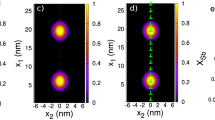Abstract
The new techniques of fine particle synthesis are shown to lead to better ceramic materials such as yttrium iron garnet (YIG) and ferroelectric lead zirconate titanate (PZT). The densities are greater than 99% of the theoretical density and the grain size can be easily controlled from 2 microns upwards. For YIG this means higher values of the nonlinear spin-wave excitation thresholdh c. For PZT the result is higher values of the tensor componentd 33 and poling voltage. It is also shown that the fine particle systems and the fine-grain microstructure lead to interesting physics results. For PZT the lowering of the peak dielectric constant, the increasing transition temperatures and the decreasing values ofd 33 with decreasing grain size can be understood in terms of the changing low-frequency cut-off of the soft lattice vibration mode. Another interesting result is that for 2000 Å size particles of α-Fe2O3 the anisotropy constant is found to be 1·38 × 102 ergs/cm3 from Mössbauer measurements.
Similar content being viewed by others
References
Anliker M, Brugger H R and Kanzig W 1954Helv. Phys. Acta 27 99
Ari-Gur P and Benguigui L 1974Solid State Commun. 15 1077
Berkowitz A E, Lahut J A, Jacobs I S, Levison L M and Forester D W 1975Phys. Rev. Lett. 34 594
Berlincourt D 1960Proc. IRE 48 220
Bhide V G and Multani M S 1965Phys. Rev. A139 1983
Biggers J V and Venkataramani S 1978Mater. Res. Bull. 13 717
Blair G R and Chaklader A C D 1973Mater. Res. Bull. 8 161
Coey J M D and Readman P W 1973Nature 246 476
Cochran W 1960Adv. Phys. 9 387
Dell R M 1973Proc. Seventh Int. Symp. Reactivity of Solids, Bristol 1972 (eds.) J S Anderson and M W Roberts (Chapman and Hall) p. 553
Dumesic J A, Topsoe H and Boudart M 1975J. Catal. 37 513
Haertling G H 1964Am. Ceram. Soc. Bull. 43 875
Holmquist W R, Kooi C F and Moss R W 1961J. Am. Ceram. Soc. 44 194
Isupov V A 1975Solid State Commun. 17 1331
Kakegawa K, Mohri J, Takahashi T, Yamamura H and Shirasaki S 1977Solid State Commun. 24 769
Kim Y S and Hart R J 1978 inProcessing of crystalline ceramics eds. H Palmour, R F Davis and T M Hare (New York: Plenum Press) p. 323
Klug H P and Alexander L 1954X-ray diffraction procedures for polycrystalline and amorphous materials (New York: John Wiley) p. 410
Kundig W, Bommel H, Constabaris G and Lindquist R H 1966Phys. Rev. 142 327
Likhite S D, Radhakrishnamurthy C and Sahasrabudhe P W 1965Rev. Sci. Instrum. 36 1558
Marshall S W and Wilenzeck R M 1966Phys. Rev. Lett. 16 219
Martirena H R and Burfoot J C 1974J. Phys. C7 3182
Morup S and Topsoe H 1976Appl. Phys. 11 63
Neel L 1949Ann. Geophys. 5 99
Palmour H, Davis R F and Hare T M (eds.) 1978Materials Science Research (New York: Plenum)11
Popma J A and Diepen van A M 1974Mater. Res. Bull. 9 1119
Paladino A E and Maguire E A 1970J. Am. Ceram. Soc. 53 98
Patton C E 1970J. Appl. Phys. 41 1637
Roy D M, Neurogaonkar R R, O’Holleran T P and Roy R 1977Am. Ceram. Soc. Bull. 56 1023
Schnettler F J 1973 30-E-73 75thMeeting Am. Ceram. Soc. April 1973
Schrooer D and Nininger R C 1967Phys. Rev. Lett. 19 632
Wolf W P and Rodrique G P 1958J. Appl. Phys. 29 105
Author information
Authors and Affiliations
Rights and permissions
About this article
Cite this article
Multani, M.S., Nanadikar, N.G., Palkar, V.R. et al. Fine particle physics and technology; some results. Bull. Mater. Sci. 2, 1–16 (1980). https://doi.org/10.1007/BF02748530
Received:
Issue Date:
DOI: https://doi.org/10.1007/BF02748530




